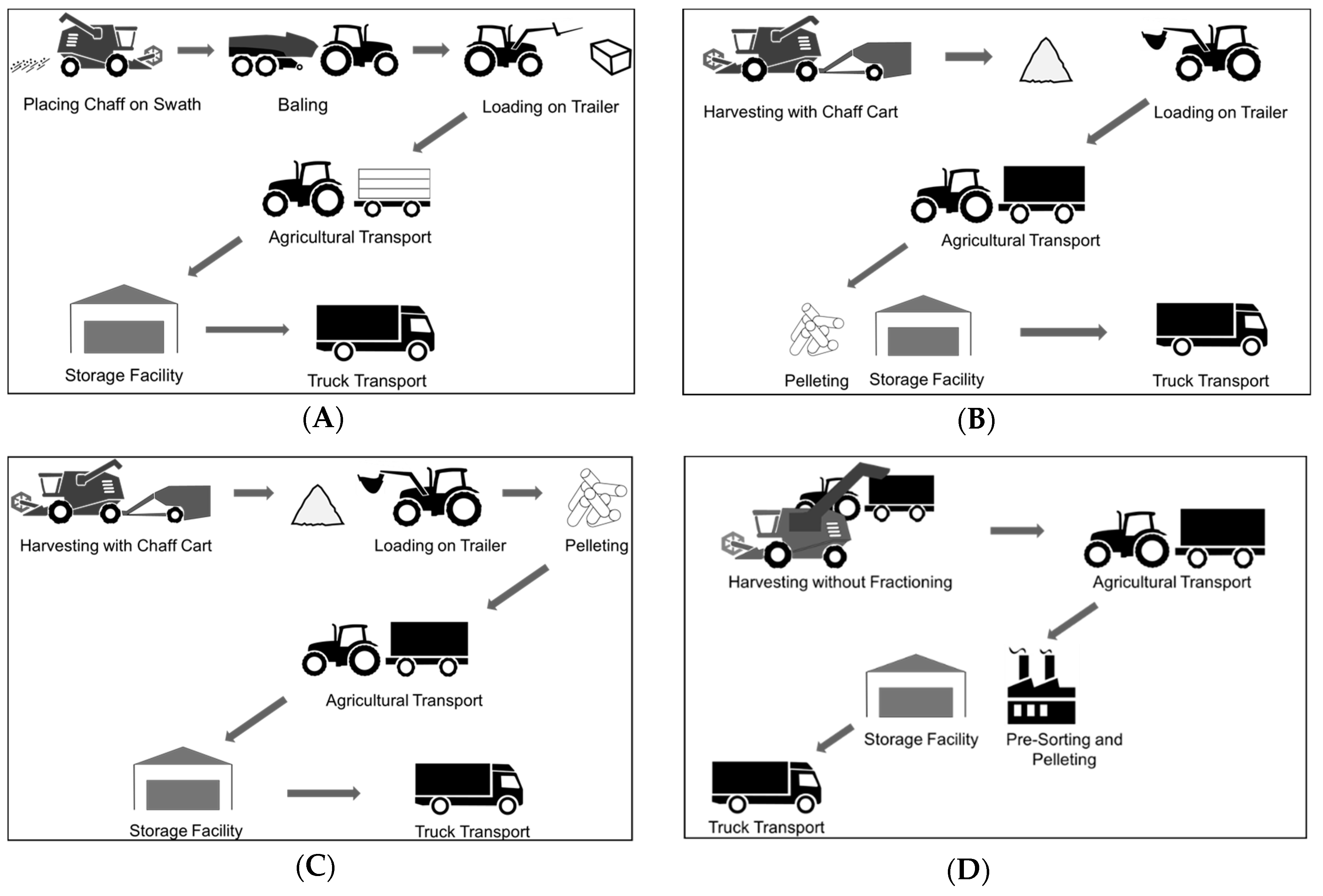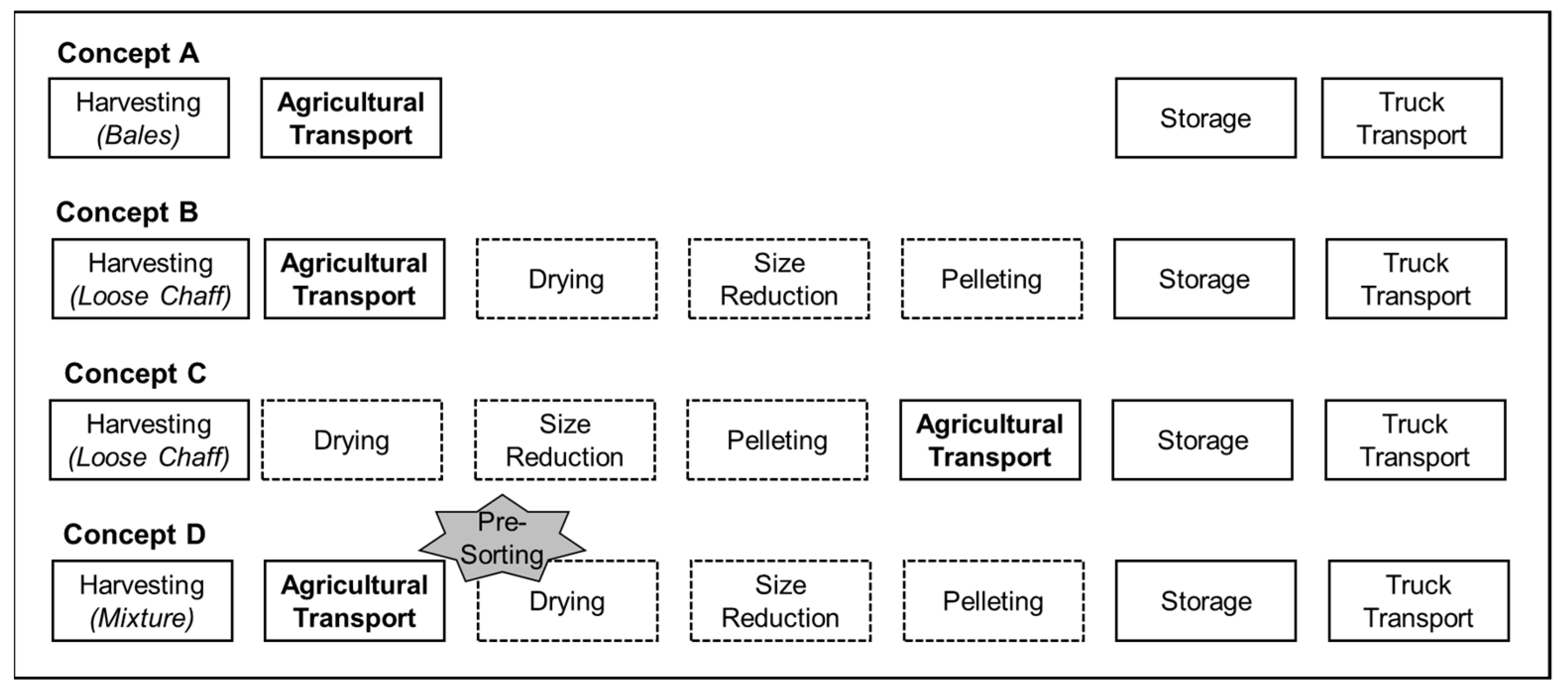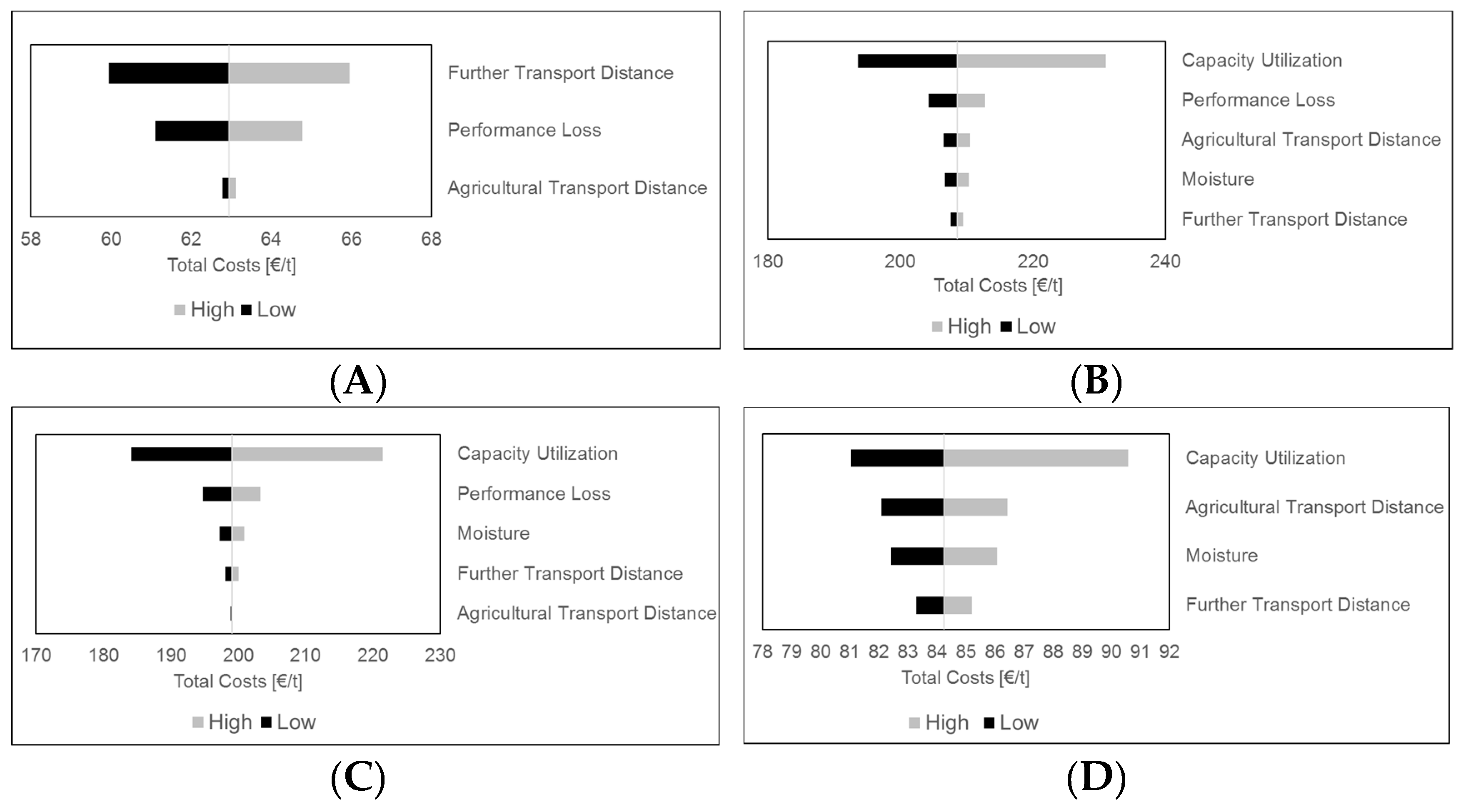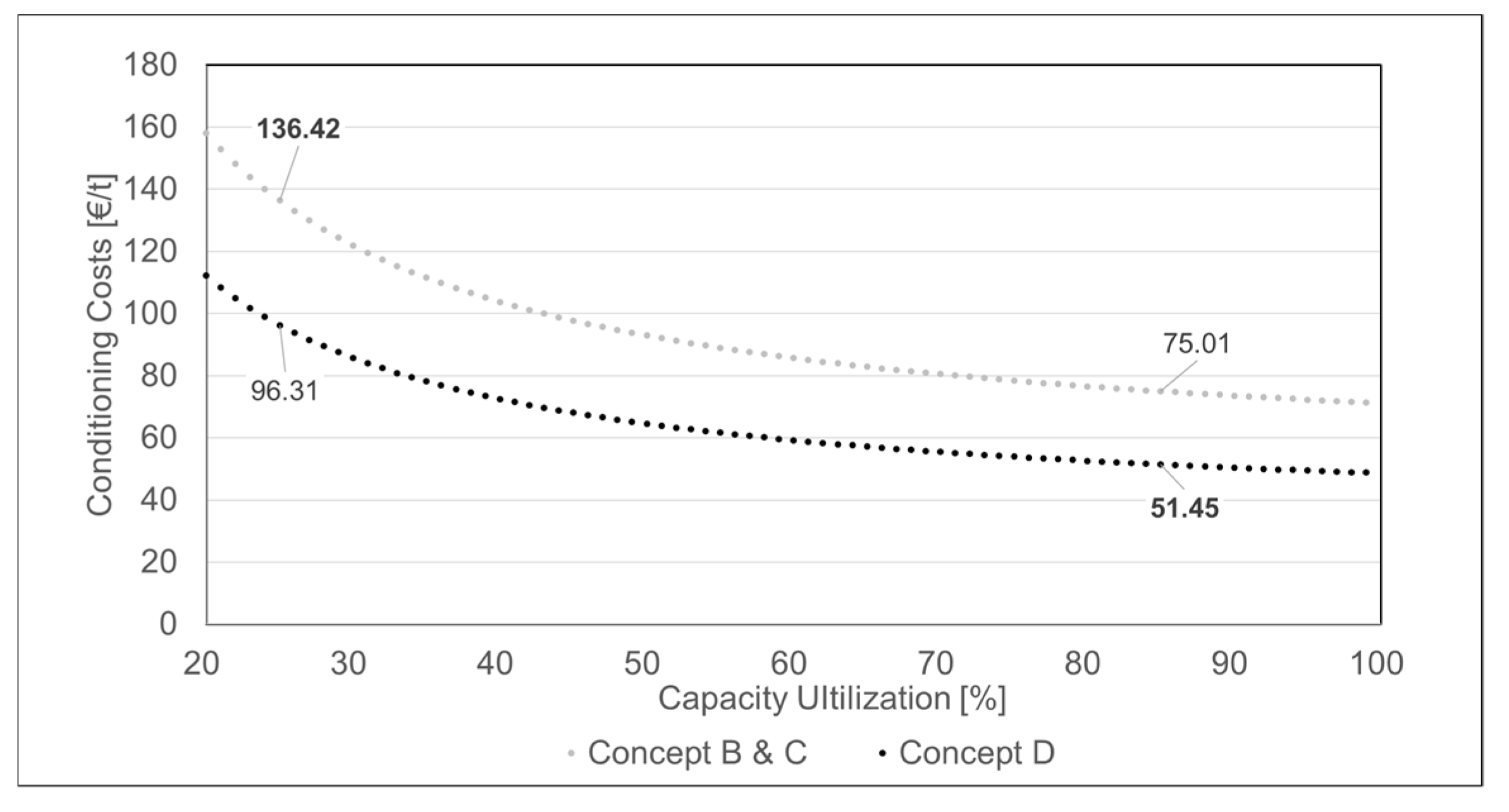Cost Analysis of Chaff Harvesting Concepts in Germany
Abstract
1. Introduction
1.1. Problem Definition
1.2. Chaff Harvesting Concepts
1.2.1. Concept A: Bales
1.2.2. Concept B and C: Chaff Piles and Pelleting
1.2.3. Concept D: Compact Harvest and Pelleting
2. Materials and Methods
2.1. Framework and Biomass Supply Chains
2.1.1. Harvesting
2.1.2. Agricultural Transport
2.1.3. Conditioning
2.1.4. Storage
2.1.5. Further Transport
2.2. Cost Estimation Methods
2.3. Sensitivity Analysis
3. Results
3.1. Chaff Supply Costs
3.2. Sensitivity Analysis
4. Discussion
4.1. Economic Efficiency
4.2. Estimate Accuracy
4.3. Applicability
5. Conclusions
Author Contributions
Funding
Conflicts of Interest
References
- Weiser, C.; Zeller, V.; Reinicke, F.; Wagner, B.; Majer, S.; Vetter, A.; Thraen, D. Integrated assessment of sustainable cereal straw potential and different straw-based energy applications in Germany. Appl. Energy 2014, 114, 749–762. [Google Scholar] [CrossRef]
- Mateos, E. Study on the Potential of Forest Biomass Residues for Bio-Energy. Proceedings 2018, 2, 1420. [Google Scholar] [CrossRef]
- Panwar, V.; Prasad, B.; Wasewar, K.L. Biomass Residue Briquetting and Characterization. J. Energy Eng. 2011, 137, 108–114. [Google Scholar] [CrossRef]
- Avcıoğlu, A.O.; Dayıoğlu, M.A.; Türker, U. Assessment of the energy potential of agricultural biomass residues in Turkey. Renew. Energy 2019, 138, 610–619. [Google Scholar] [CrossRef]
- 36th Regulation for the Implementation of the Federal-Immision Protection. Regulation for the Implementation of the Regulations for the Contingent of Biofuels. Available online: http://www.gesetze-im-internet.de/bimschv_36/ (accessed on 18 September 2019).
- Miu, P. Combine Harvesters: Theory, Modeling, and Design; CRC Press: Boca Raton, FL, USA, 2015; pp. 1–54. ISBN 9781138748279. [Google Scholar]
- Glasner, C.; Vieregge, C.; Robert, J.; Fenselau, J.; Bitarafan, Z.; Andreasen, C. Evaluation of New Harvesting Methods to Reduce Weeds on Arable Fields and Collect a New Feedstock. Energies 2019, 12, 1688. [Google Scholar] [CrossRef]
- Shirtliffe, S.J.; Entz, M.H. Chaff collection reduces seed dispersal of wild oat (Avena fatua) by a combine harvester. Weed sci. 2005, 53, 465–470. [Google Scholar] [CrossRef]
- Heap, I. The International Survey of Herbicide Resistant Weeds. Available online: http://www.weedscience.org/Summary/CountrySummary.aspx (accessed on 22 March 2019).
- Anon. European Parliament Resolution of 13 September 2018 on the Implementation of the Plant Protection Products Regulation (EC) No 1107/2009 (2017/2128(INI)). Available online: http://www.europarl.europa.eu/ (accessed on 18 September 2019).
- EUROSTAT. Wheat and Spelt by Area, Production and Humidity. Available online: http://ec.europa.eu/eurostat/tgm/table.do?tab=table&init=1&language=en&pcode=tag00047&plugin=1 (accessed on 18 November 2018).
- Glasner, C.; Andreasen, C.; Vieregge, C.; Dikiy, A.; Fenselau, J.; Bitarafan, Z.; Shumilina, E. Adaptions of Harvesting Methods and Concepts in order to Reduce Weeds on Agricultural Fields and to Gain Potentially a So Far Unexploited Biomass Feedstock. Eur. Biomass Conf. Exhib. Proc. 2018, 2018, 64–70. [Google Scholar] [CrossRef]
- Rumpler, J. Wertschöpfungsmöglichkeiten und Marktpotenziale für die Ernteprodukte Spreu, Stroh und SpreuStroh bei der Nutzung als landwirtschaftliche Reststoff-Biomasse. Available online: https://llg.sachsen-anhalt.de/fileadmin/Bibliothek/Politik_und_Verwaltung/MLU/LLFG/Dokumente/ 04_themen/technik/2017_Studie_Wertschoepfung.pdf (accessed on 3 January 2018).
- Croker, K.; Watt, P. The Good Food Guide for Sheep: Feeding Sheep for Meat Production in the Areas of Western Australia. Available online: https://researchlibrary.agric.wa.gov.au/cgi/viewcontent.cgi?article=1177&context=bulletins (accessed on 4 January 2019).
- Hutton, G. Increasing Cow/Calf Profitability Using Chaff and Chaff/Straw Feedstuffs. Available online: https://www1.agric.gov.ab.ca/$department/deptdocs.nsf/all/agdex1156 (accessed on 9 January 2019).
- Esmail, A.; Tawfik, M. The Concept of Sustainable Architecture and Urbanization in Dakhla and Kharga Oases in Egypt. WIT Trans. Build Environ. 2016, 159, 61–71. [Google Scholar] [CrossRef]
- Rudolph, W. Mit der Kompakternte neue Wege der Vermarktung öffnen. Bauernzeitung 2016, 40, 10–13. [Google Scholar]
- Rumpler, J.; Beneke, F. Harvest All at Once. Available online: https://www.researchgate.net/publication/281120054_Harvest_all_at_once (accessed on 20 November 2018).
- Rumpler, J.; Beneke, F. Pragmatists Required! Available online: https://www.researchgate.net/publication/281120264_Pragmatists_required (accessed on 17 October 2018).
- MR Laufen. Verrechnungssätze 2017. Available online: https://www.mrlaufen.de/images/bilder/ verrechnungssaetze/2017/verrechnungssaetze_2017_a6_quer_4c.pdf (accessed on 11 October 2018).
- MR Stade. Verrechnungssätze Maschinenring Stade 2018. Available online: http://www.maschinenring-stade.de/index.php/download.html?file=files/mr/ (accessed on 10 January 2019).
- LWK NRW. Erfahrungssätze für Maschinenring-Arbeiten unter Landwirten. Available online: https://www.landwirtschaftskammer.de/landwirtschaft/beratung/pdf/erfahrungssaetze-wl.pdf (accessed on 11 October 2018).
- Rentizelas, A.A.; Tolis, A.J.; Tatsiopoulos, I.P. Logistics issues of biomass: The storage problem and the multi-biomass supply chain. Renew. Sustain. Energy Rev. 2009, 13, 887–894. [Google Scholar] [CrossRef]
- Herrmann, A.; Pickel, P.; Fröba, N. Transportgeschwindigkeit von Traktoren: Auswirkung unterschiedlicher bauartbedingter Höchstgeschwindigkeiten. Landtechnik 2000, 55, 338–339. [Google Scholar]
- Mani, S.; Sokhansanj, S.; Bi, X.; Turhollow, A. Economics of producing fuel pellets from biomass. Appl. Eng. Agric. 2006, 22, 421–426. [Google Scholar] [CrossRef]
- Weiß, B.D.; Glasner, C. Evaluation of the Process Steps of Pretreatment, Pellet Production and Combustion for an Energetic Utilization of Wheat Chaff. Front. Environ. Sci. 2018, 6, 1313. [Google Scholar] [CrossRef]
- Mujumdar, A.S. Handbook of Industrial Drying, 4th ed.; CRC Press: Boca Raton, FL, USA, 2015; ISBN 9781466596658. [Google Scholar]
- DLG e. V. Getreide Sicher lagern: Reinigen, Trocknen und Kühlen. Available online: https://www.dlg.org/fileadmin/downloads/merkblaetter/dlg-merkblatt_425.pdf (accessed on 15 January 2019).
- Amos, W. Report on Biomass Drying Technology. Available online: https://www.nrel.gov/docs/fy99osti/25885.pdf (accessed on 24 October 2018).
- Mujumdar, A.S. Classification and Selection of Industrial Dryers. Available online: https://www.researchgate.net/publication/265533511_CLASSIFICATION_AND_SELECTION_OF_INDUSTRIAL_DRYERS (accessed on 28 November 2018).
- Grube, J.; Böckelmann, M. The harvest home and dry—Key figures for grain drying. Landtechnik 2011, 66, 276–280. [Google Scholar]
- PCM Green Energy. Pelletieranlage. Available online: https://www.pcm-greenenergy.de/de/pelletieranlage/ (accessed on 17 January 2019).
- Thek, G.; Obernberger, I. Wood pellet production costs under Austrian and in comparison to Swedish framework conditions. Biomass Bioenergy 2004, 27, 671–693. [Google Scholar] [CrossRef]
- PCM Green Energy. Technische Daten. Available online: https://www.pcm-greenenergy.de/de/pelletieranlage/#toggle-id-5 (accessed on 17 January 2019).
- Kaltschmitt, M.; Hartmann, H.; Hofbauer, H. Energie aus Biomasse. Grundlagen, Techniken und Verfahren, 3rd ed.; Aktualisierte und Erweiterte Auflage; Springer Vieweg: Berlin/Heidelberg, Germany, 2016; ISBN 978-3-662-47437-2. [Google Scholar]
- Schaider Pelletech. So Arbeitet Schaider Pelletec D 8.0. Available online: http://www.schaider-group.com/media/folder_pelletec_d.pdf (accessed on 17 January 2019).
- KRONE. Premos 5000 Mobiler Pellet-Vollernter. Available online: https://landmaschinen.krone.de/english/products/pellet-harvester/premos-5000/ (accessed on 17 January 2019).
- Neumann, H. Pelletierung auf Rädern. Eilbote 2015, 23, 10–14. [Google Scholar]
- Ortiz, D.S.; Curtright, A.E.; Samaras, C.; Litovitz, A.; Burger, N. Near-Term Opportunities for Integrating Biomass into the U.S. Electricity Supply. Technical Considerations; Rand: Santa Monica, CA, USA, 2011; ISBN 978-0-8330-5835-5. [Google Scholar]
- Sokhansanj, S.; Turhollow, A.; Wilkerson, E. Development of the Integrated Biomass Supply Analysis and Logistics Model (IBSAL); Oak Ridge National Laboratory: Oak Ridge, TN, USA, 2008; ORNL/TM-2006/57. [Google Scholar]
- Liguori, P. Analysis: China-Europe Rail Growth Belies EU Rail Challenges. Available online: https://www.joc.com/rail-intermodal/international-rail/analysis-europe-wide-rail-freight-would-be-pro-commerce-green_20180226.html (accessed on 11 January 2019).
- AACE International. Cost Estimate Classification System—As Applied in Engineering, Procurement, and Construction for the Process Industries; AACE International Recommended Practice No. 18R-97; AACE Inc.: Morgantown, WV, USA, 2011. [Google Scholar]
- Degner, J. Kosten und Arbeitsaufwand der Strohbergung mit Quaderballenpresse bei Feldrandfreilagerung. Available online: http://www.tll.de/www/daten/publikationen/richtwerte/stro0907.pdf (accessed on 13 February 2019).
- Crundwell, F.K. Finance for Engineers: Evaluation and Funding of Capital Projects; Springer: London, UK, 2008; ISBN 978-1-84800-032-2. [Google Scholar]
- Valentas, K.J. Handbook of Food Engineering Practice; CRC Press: Boca Raton, FL, USA, 1997; ISBN 9780849386947. [Google Scholar]
- Wirtschaftlichkeit gebäudetechnischer Anlagen—Grundlagen und Kostenberechnung; VDI 2067 Blatt 1: 2012-09; Beuth-Verlag: Berlin, Germany, 2012.
- Wesenberg, M. Die Mähdrusch-Kosten sind enorm gestiegen: Lohnunternehmer müssen scharf kalkulieren. Landwirtschaftliches Wochenblatt 2015, 24, 15–16. [Google Scholar]
- Schwarz, B. Strohbasierte Biogaspellets als Alternatives Inputsubstrat in Biogasanlagen: Fachtagung “Biogas aus Stroh”, 30.08.2016 in Heiden. Available online: https://docplayer.org/78090440-Strohbasierte-biogaspellets-als-alternatives-inputsubstrat-in-biogasanlagen.html (accessed on 4 January 2019).
- RBCN. Rotterdam Biomass Commodities Network. BiomassMarket Update. Available online: https://rbcn.nl/wp-content/uploads/bsk-pdf-/2018/01/2018-Q1-RBCN-BMU.pdf (accessed on 1 February 2019).
- Paligo. Strohgranulat Einstreu. Available online: https://www.paligo.de/tierbedarf/tiereinstreu/strohgranulat-einstreu/ (accessed on 6 January 2019).
- agrarheute. Strohpreise: Soviel kostet der Großballen. Available online: https://www.agrarheute.com/pflanze/strohpreise-soviel-kostet-grossballen-441423 (accessed on 28 February 2019).
- Dwivedi, D.N. Microeconomics: Theory and Applications; Pearson Education: New Delhi, India, 2006; ISBN 8177586483. [Google Scholar]
- Zwart, R.; de Boe, M. Market Analysis for the Start of a Biomass Commodities Exchange. Available online: http://www.biomassconsultancy.com/Publications/Market%20Analysis%20Biomass%20Commodities%20Exchange%20August%202010.pdf (accessed on 1 February 2019).





| Parameter | Specification | Concept | Assumption |
|---|---|---|---|
| Transport distances | Field-farm | A, B, C | 2 km |
| Field-central plant | D | 16 km | |
| Further transport | A, B, C, D | 50 km | |
| Performance loss during harvesting | A, B, C | 18% | |
| Initial moisture chaff | A, B, C, D | 25% (w/w) | |
| Capacity utilization | Decentralized plant | B, C | 25% |
| Central plant | D | 85% |
| Concept | Harvesting | Agricultural Transport | Condi-Tioning | Storage | Further Transport | Total Costs |
|---|---|---|---|---|---|---|
| A [€/t*] | 30.17 | 6.14 | 16.93 | 15.02 | 62.94 | |
| B [€/t**] | 44.95 | 9.79 | 136.42 | 12.62 | 4.76 | 208.53 |
| C [€/t**] | 44.95 | 0.55 | 136.42 | 12.35 | 4.76 | 199.02 |
| D [€/t**] | 8.54 | 10.51 | 51.45 | 9.00 | 4.76 | 84.25 |
© 2019 by the authors. Licensee MDPI, Basel, Switzerland. This article is an open access article distributed under the terms and conditions of the Creative Commons Attribution (CC BY) license (http://creativecommons.org/licenses/by/4.0/).
Share and Cite
Unger, J.S.; Glasner, C. Cost Analysis of Chaff Harvesting Concepts in Germany. Agronomy 2019, 9, 579. https://doi.org/10.3390/agronomy9100579
Unger JS, Glasner C. Cost Analysis of Chaff Harvesting Concepts in Germany. Agronomy. 2019; 9(10):579. https://doi.org/10.3390/agronomy9100579
Chicago/Turabian StyleUnger, Jannike Sophie, and Christoph Glasner. 2019. "Cost Analysis of Chaff Harvesting Concepts in Germany" Agronomy 9, no. 10: 579. https://doi.org/10.3390/agronomy9100579
APA StyleUnger, J. S., & Glasner, C. (2019). Cost Analysis of Chaff Harvesting Concepts in Germany. Agronomy, 9(10), 579. https://doi.org/10.3390/agronomy9100579





